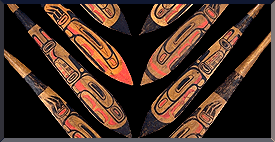 |
Dugout Canoe Construction
Before metal tools were readily available, First Peoples often hollowed out dugouts by burning them with controlled fires and then removing the charred wood with an adze. Another technique was to chop notches across the inside width of the canoe and then split out the wood between the notches, repeating the whole process until the desired depth was achieved. In more recent times, chain-saws have been used to eliminate the laborious chopping of notches as well as to rough out the exterior shape of the hull. Seagoing canoes of the Pacific Coast were often widened through soaking the hull with hot water and spreading the gunwales apart.
 |
| Unfinished West Coast-style dugout canoe Port Renfrew, British Columbia CMC VII-F-945 |
Construction stages
- Taking down the bottom surface with an axe.
- Levelling and smoothing the bottom of the hull with an adze.
- Removing wood from the interior with a double-bladed axe.
- Dressing the interior with a cooper's adze.
- Smoothing the interior with a curved drawknife.
- Shaping the sides of the separate bow head.
- Fitting the head to the bow.
- Sanding the inside of the canoe.
 |
Paddles were sometimes decorated with painted figures |
| kayaks | umiaks | bark canoes | dugout canoes exhibition photos | conservation | bibliography | other WWW resources credits |
 |